Overview
The article titled "10 Signs of Autism Spectrum Disorder Every Parent Should Know" highlights essential indicators of autism spectrum disorder (ASD) that every parent should be aware of. Recognizing early signs—such as limited eye contact, communication difficulties, and repetitive behaviors—can significantly impact a child's developmental journey.
Timely intervention, as supported by research and statistics, can lead to improved outcomes for children with ASD. By understanding these signs, parents can take proactive steps to seek support and resources, fostering a nurturing environment for their child's growth.
Introduction
Navigating the complexities of autism can feel overwhelming for families. The signs and symptoms can vary widely among individuals, making it a unique journey for each. From early developmental delays in infants to the distinct challenges faced by adults on the spectrum, understanding autism requires a compassionate and nuanced approach.
This exploration delves into the various indicators of autism across different age groups, emphasizing the critical importance of early recognition, intervention, and community support. By shedding light on these essential aspects, parents and caregivers can better equip themselves with the knowledge and resources necessary to foster meaningful connections.
Together, we can enhance the quality of life for those affected by autism, creating a supportive environment that nurtures growth and understanding.
About ASD Media: Comprehensive Resources for Autism Support
At ASD Media, we understand the challenges parents and professionals face in implementing ABA therapy. That’s why we are dedicated to providing a comprehensive array of resources and support tailored just for you. Our organization aims to create a nurturing community where individuals can share their experiences and learn from one another, fostering a sense of belonging and connection.
By subscribing to our newsletter, you will gain access to the latest insights and strategies designed to address the challenges in therapy. These resources are crafted to lead to improved outcomes for children with developmental disorders and ADHD. It’s important to note that, according to a study published in JAMA Pediatrics, the average medical expense for a young person with a developmental disorder is around $17,000 annually. This statistic highlights the vital role community assistance and resources play in effectively managing these conditions.
Our commitment to community support is crucial. It empowers caregivers and enhances the effectiveness of therapy interventions, ensuring that both children and their families receive the necessary guidance and resources. Additionally, the case study titled 'Treatment, Intervention, and Support' sheds light on the diverse treatment approaches for signs of autism spectrum disorder. It reveals the differing support needs between mothers and fathers, reinforcing the importance of a collaborative community in achieving successful therapy outcomes.
We invite you to join our community, share your experiences, and access the resources that can make a difference in your journey. Together, we can create a supportive environment that nurtures growth and understanding.
Early Signs of Autism: Recognizing Developmental Delays in Infants
As a parent, it's important to stay attentive to potential signs of developmental delays in your infant. Be mindful of signs of autism spectrum disorder, including:
- Limited eye contact
- A lack of response to their name
- Reduced social smiling
Research shows that some young ones may exhibit these early signs as early as six months. The Mayo Clinic emphasizes, "Monitoring a young one's development closely during this critical period is essential," highlighting the importance of your vigilance.
In fact, statistics reveal that individuals born in 2018 underwent more assessments and identification of autism spectrum disorder (ASD) during ages 0–4 compared to those born in 2014. This shift underscores the growing awareness and initiatives aimed at early intervention. Moreover, recent studies indicate that 78.8% of school-age autistic youths demonstrate positive developmental outcomes by age 10. This suggests that early recognition and intervention can lead to significant improvements in their lives.
By being proactive and observant, you can play a crucial role in supporting your child's development and accessing the necessary resources. If you notice any early indicators that may be signs of autism spectrum disorder, consider seeking an assessment or exploring further resources. Remember, your attentiveness can make a meaningful difference in ensuring your child receives the support they need.
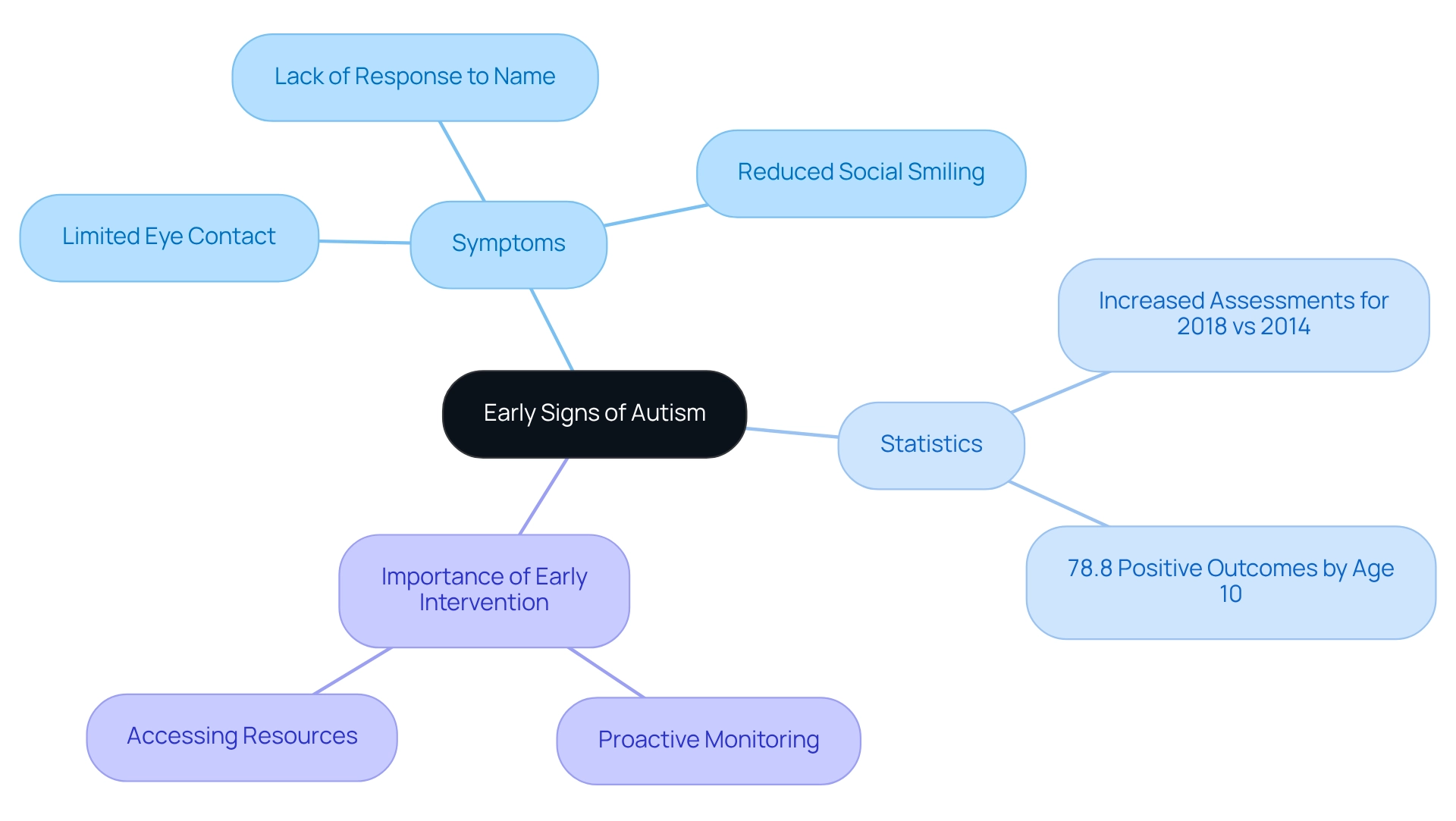
Social Communication Difficulties: Identifying Key Indicators of Autism
Recognizing communication difficulties in children with autism can be daunting for many parents. Key indicators include:
- A lack of back-and-forth conversation
- Trouble interpreting cues
- Challenges in sharing interests with peers
Research shows that numerous children exhibit signs of autism spectrum disorder by 12 to 18 months of age, emphasizing the vital role of early recognition among parents and caregivers. Autism Speaks highlights that these signs can present differently across individuals, which underscores the necessity for heightened awareness.
In the wake of the COVID-19 pandemic, a recent analysis titled "Evaluation and Identification After COVID-19 Pandemic Onset" revealed disruptions in evaluations and ASD identifications. However, by mid-2020, a return to higher identification rates was observed. This underscores the ongoing need for vigilance in recognizing communication difficulties within our communities. Authorities recommend nurturing an awareness of interpersonal signals, as this is crucial for enhancing interactions. Tailored approaches can significantly boost communication growth in youth with developmental disorders.
It’s noteworthy that surveys indicate 36.5% of caregivers for individuals with developmental disorders utilize ABA therapy, with many reporting positive outcomes. This reinforces the value of customized approaches. Furthermore, Individualized Education Programs (IEPs) play a crucial role in fostering academic success for autistic students. By focusing on these essential indicators and understanding the social factors influencing ASD prevalence, parents can better support their children in navigating social settings and forming meaningful relationships. Together, we can create a more understanding and supportive environment for our children.
Repetitive Behaviors: Understanding Common Patterns in Autism
Repetitive actions, such as hand-flapping and rocking, are common signs of autism spectrum disorder among youngsters and often serve as vital coping strategies. These behaviors can help children manage anxiety and sensory overload, providing comfort in overwhelming situations. For parents, understanding these behaviors is essential, as they can reveal underlying emotional or sensory needs.
Statistics show that repetitive behaviors are significantly linked with adaptive behavior and socialization scores in young individuals showing signs of autism spectrum disorder as early as 24 months. This underscores the importance of early identification and intervention in addressing signs of autism spectrum disorder; addressing these behaviors can lead to improved outcomes. According to the case study titled "Summary of Autism Prevalence," approximately 1 in 54 youths in the U.S. are diagnosed with developmental disorders, with variations based on gender, race, and geography. By recognizing these common patterns, parents can offer targeted support and interventions.
Effective coping methods for youngsters with autism include:
- Establishing organized routines
- Providing sensory breaks
- Utilizing visual aids to enhance communication
These strategies are crucial for helping young individuals navigate their unique challenges. By fostering an understanding of these behaviors, parents can better support their children, ultimately promoting a more inclusive environment.
As Temple Grandin, a notable advocate for neurodiversity, poignantly stated, "I am different, not less." This sentiment resonates deeply within the neurodiverse community, highlighting the importance of understanding and supporting the unique experiences of individuals with this condition. Together, we can create a more compassionate world for our children.
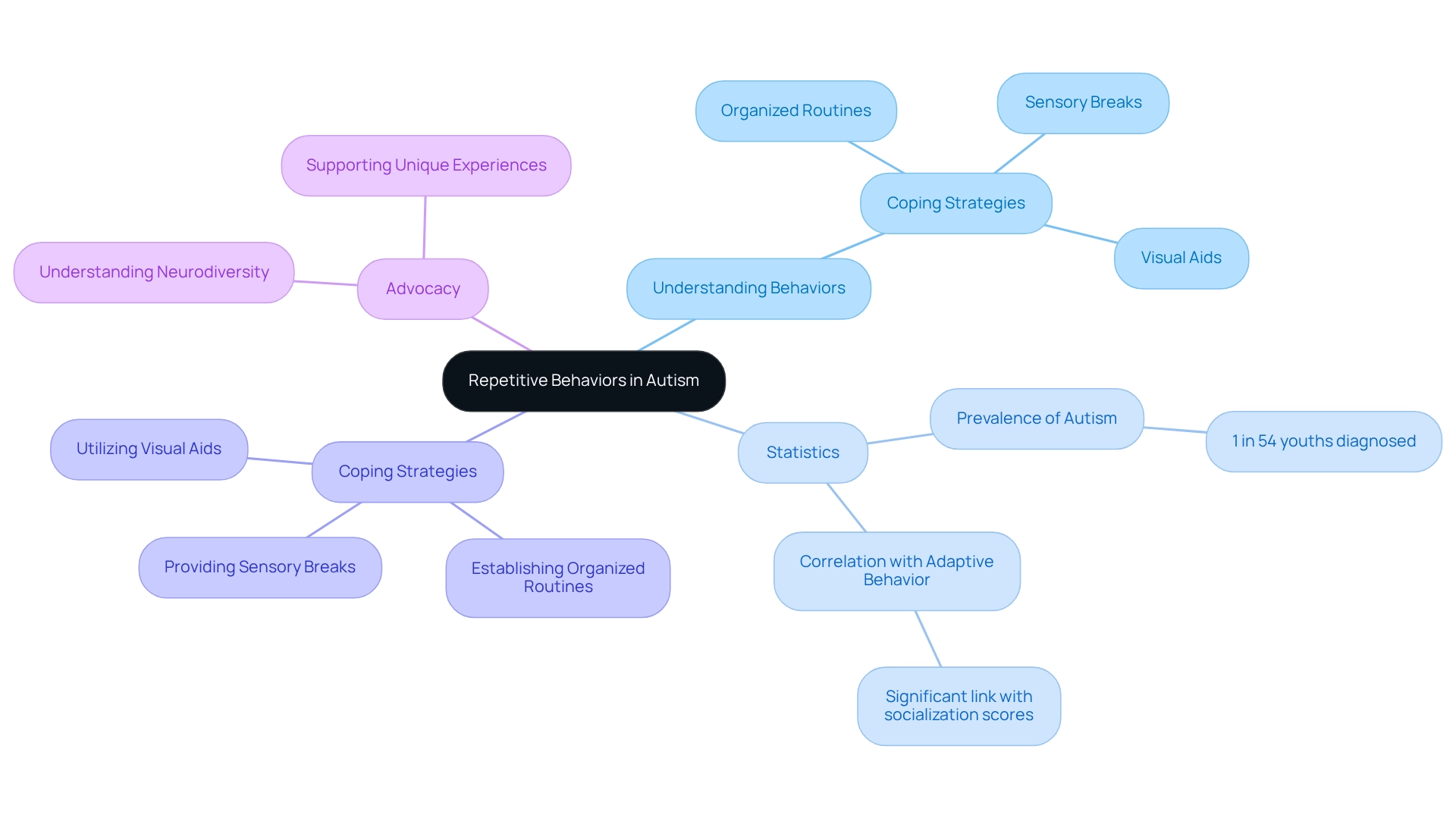
Sensory Sensitivities: Recognizing Overreactions to Stimuli in Children
Children exhibiting signs of autism spectrum disorder often experience heightened sensitivities to sensory stimuli, which can lead to overreactions to loud noises, bright lights, or specific textures. These sensitivities can cause significant distress and meltdowns, making it essential for caregivers to closely observe their children's reactions in various environments. Research indicates that over 96% of children showing signs of autism spectrum disorder (ASD) face either hypersensitivity or hyposensitivity to sensory inputs, underscoring the prevalence of these challenges. This statistic highlights the vital need for parents to understand and address their children's sensory sensitivities.
To effectively manage sensory overload, parents should consider implementing strategies tailored to their children's unique needs. For example, creating accommodating environments, as illustrated in the case study 'Addressing Sensory Seeking Behaviors in Autism,' can greatly enhance daily experiences, allowing autistic individuals to thrive. Observing and documenting specific triggers can help in making necessary adjustments, such as minimizing exposure to overwhelming stimuli or providing calming tools like noise-canceling headphones, especially for those showing signs of autism spectrum disorder. Case studies emphasize the importance of understanding sensory challenges, showing that targeted strategies can lead to improved outcomes for individuals with signs of autism spectrum disorder. In 2025, experts stress the need for ongoing education about sensory sensitivities, advocating for collaborative approaches that empower both parents and professionals. By fostering an inclusive community, we can share insights and strategies that support children in navigating their sensory worlds more effectively.
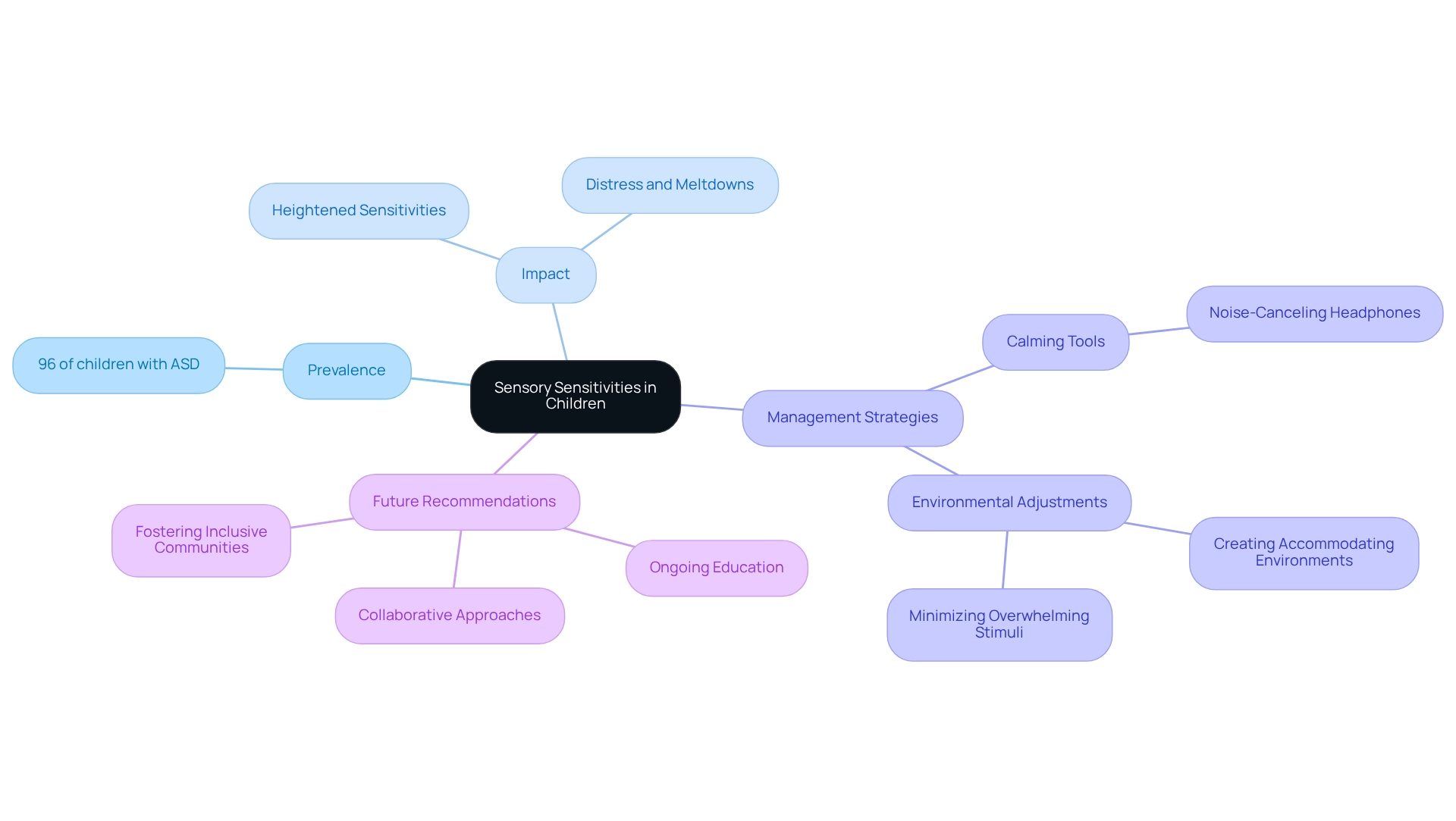
Emotional and Behavioral Signs: Identifying Distress and Anxiety in Autism
Children with developmental disorders may exhibit various signs of autism spectrum disorder, such as increased irritability, social withdrawal, and sudden emotional outbursts. These behaviors often indicate underlying anxiety or frustration, prompting the need for proactive intervention from parents. Recent data reveals that anxiety disorders are common among youth with developmental disorders. Studies indicate that emotional and behavioral signs of distress are prevalent indicators. The CDC emphasizes the importance of identifying signs of autism spectrum disorder promptly, stating that 'early detection and intervention can greatly enhance results for youth with developmental disorders.'
For instance, the significant rise in peer-reviewed research on autism—from 800 articles in 2003 to 3,400 in 2013—underscores the growing awareness of these issues. However, this increase also highlights the pressing need for improved support for parents in planning for the future, as many express concerns about their children's development. Furthermore, statistics show that in Arizona, the occurrence of signs of autism spectrum disorder is 26.8 per 1,000, reinforcing the importance of recognizing these signs in a broader emotional context.
Experts recommend effective strategies for addressing anxiety in youths who exhibit signs of autism spectrum disorder, such as:
- Establishing structured environments
- Enhancing interpersonal skills
- Providing emotional support tailored to individual needs
Additionally, social workers should receive training to help families navigate these challenges. By understanding and recognizing these emotional indicators, caregivers can better assist their children in managing anxiety and improving their overall quality of life.
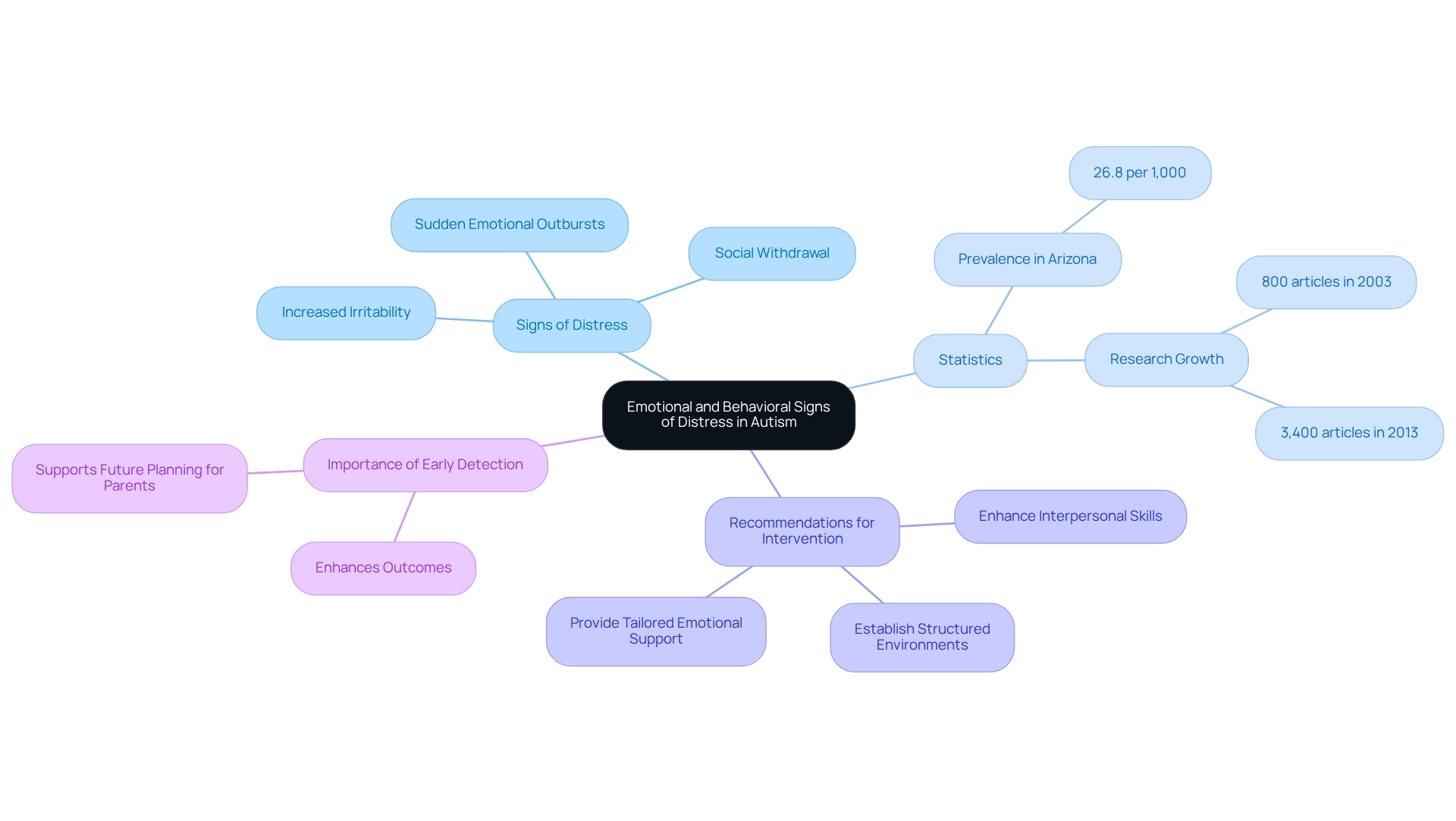
Signs of Autism in Girls: Recognizing Unique Behavioral Patterns
Girls with developmental differences often show fewer overt repetitive behaviors and possess a remarkable ability to conceal their symptoms. This can lead to challenges in early identification, leaving parents and caregivers feeling uncertain. While these girls may demonstrate strong social skills, they frequently grapple with the subtleties of social interactions. This makes it essential for those who care for them to be attentive and vigilant in spotting these nuanced signs of autism spectrum disorder.
Research highlights that many girls display signs of autism spectrum disorder and remain undiagnosed until later in life, underscoring the importance of awareness and timely intervention. It's crucial to understand that the prevalence of developmental disorder diagnosis varies across different demographics. Girls often exhibit unique patterns that set them apart from their male counterparts. For example, Asian or Pacific Islander children are diagnosed at a rate of 1 in 30, while the prevalence percentages for various races include:
- Children of multiple races at 2.27%
- White at 2.44%
- American Indian at 2.63%
- Black at 2.94%
- Hispanic at 3.12%
- Asian at 3.33%
- Pacific Islander at 3.33%
Understanding these differences is vital for ensuring that girls receive the support they need. Masking symptoms can complicate their experiences, making awareness even more important. Insights from the case study titled "Which Internal Singleton MFOR?" shed light on recognition bias and gender ratios in ASD, emphasizing the complexities surrounding gender disparities in diagnoses.
Effective interventions tailored to the unique needs of girls with signs of autism spectrum disorder can significantly improve outcomes. This highlights the importance of focused strategies in both diagnosis and treatment. By fostering an environment of understanding and support, we can help ensure that every girl receives the care she deserves.
Signs of Autism in Older Children and Teens: Evolving Behaviors to Watch For
As children transition into their teenage years, signs of autism may manifest in various ways, particularly through increased anxiety during interactions and difficulties in forming peer relationships. Research shows that interpersonal anxiety is common among autistic teens, often resulting in challenges when adapting to new environments and social situations. For example, many autistic adolescents report feeling overwhelmed in social settings, which can significantly hinder their ability to connect with their peers.
A study titled "Hope and Growth in Autistic Youth" reveals that numerous individuals with severe language delays eventually develop language skills, with an impressive 78.8% of school-age autistic individuals thriving in at least one developmental area by age 10. This finding highlights the potential for positive outcomes, even amidst the ongoing challenges associated with Autism Spectrum Disorder (ASD).
In 2025, the understanding of autism signs in older children and teens continues to evolve, prompting parents to recognize these indicators early. Key signs to be aware of include:
- Heightened social anxiety, which may present as avoidance of social interactions or difficulty in initiating conversations.
- Struggles with peer relationships, often leading to feelings of isolation or frustration.
- Challenges in adapting to new environments, such as changes in school or social settings.
Recent statistics indicate that the prevalence of autism spectrum disorder among American Indian/Alaska Native children is 26.8 per 1,000, underscoring the necessity of awareness across different demographics.
Understanding these signs is crucial for guardians and caregivers, as it empowers them to seek appropriate support and interventions. Experts emphasize the importance of nurturing social skills and providing strategies to help teens navigate their social worlds effectively. Social workers play a vital role in assisting caregivers in preparing for their child's future, simplifying the process into manageable steps.
Moreover, the average costs of typical services for individuals with developmental disorders in the U.S. can be significant, with adaptive behavior services averaging $82.25 and speech/language therapy costing around $174.80. This financial context is important for guardians contemplating support options.
As noted by Williams AR in the MMWR Surveillance Summary, comprehending the prevalence and characteristics of spectrum disorder is essential for effective intervention. By being proactive and informed, parents can empower their children to manage anxiety and cultivate meaningful connections with their peers.
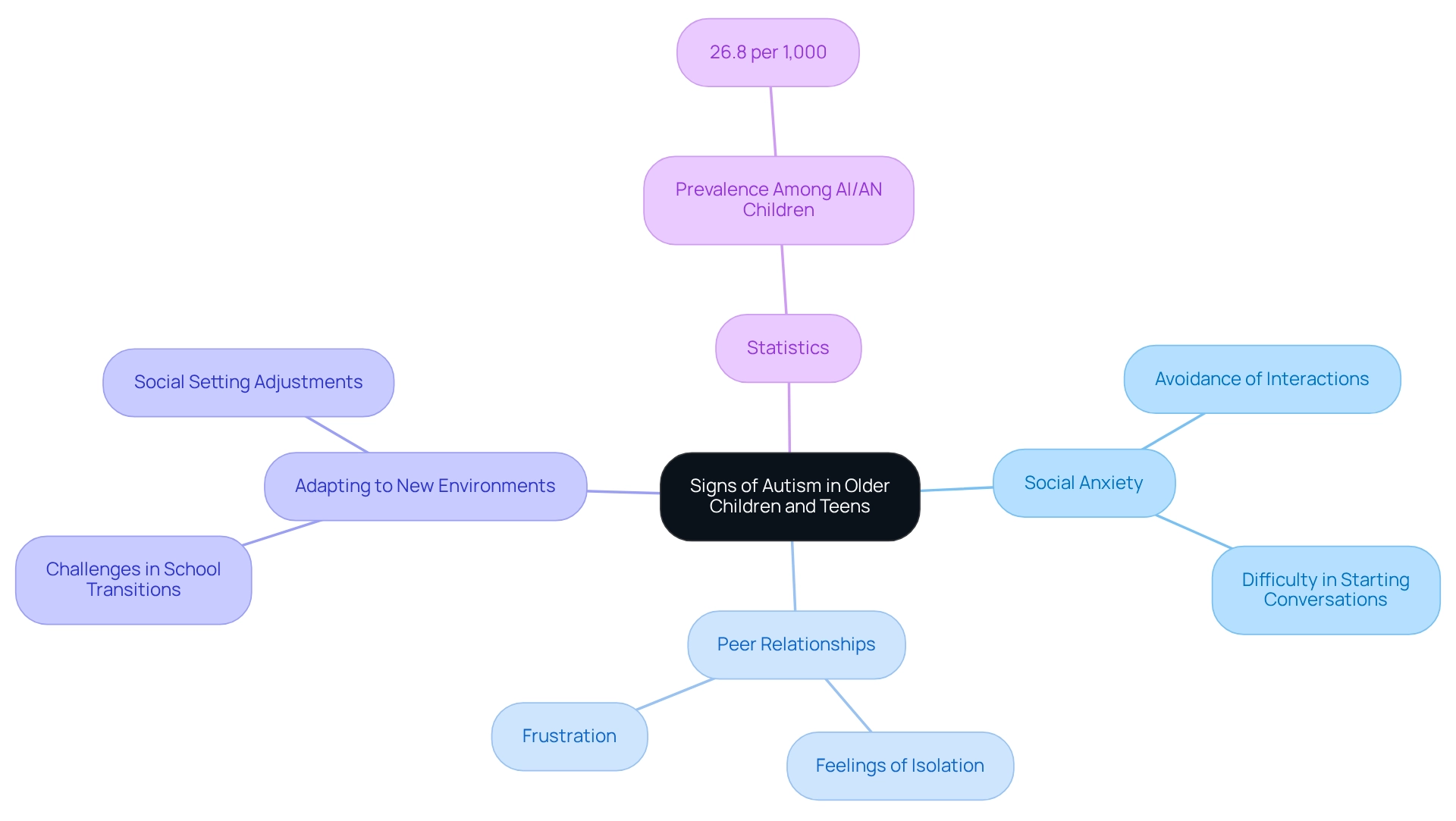
Signs of Autism in Adults: Recognizing Lifelong Patterns and Needs
Adults with developmental differences often face significant challenges, including:
- Difficulties in interpersonal interactions
- Communication hurdles
- Heightened sensory sensitivities
These individuals may exhibit repetitive behaviors or develop intense interests that can dominate their focus. Recognizing the signs of autism spectrum disorder is crucial for ensuring that adults receive the necessary support across various life domains, such as employment and social settings. Research shows that communication difficulties are common among autistic adults, with many experiencing challenges that impact their daily interactions. In fact, 80% of our expert clinicians identify as neurodivergent or have a close connection to neurodivergence, underscoring the importance of acknowledging the signs of autism spectrum disorder. A diagnosis can pave the way for greater independence and a fulfilling life for autistic adults, making it essential to provide appropriate resources.
Understanding these lifelong patterns not only helps in delivering necessary support but also fosters a more inclusive environment where autistic individuals can thrive. Effective support strategies, including tailored communication approaches and sensory accommodations, are vital for enhancing the quality of life for adults on the spectrum. By recognizing the signs of autism spectrum disorder and implementing supportive measures, we can empower autistic adults to navigate their unique experiences more successfully. Additionally, there are various resources available to assist autistic adults in overcoming challenges in a neurotypical world. This highlights the importance of access to these resources for improving overall well-being. Together, we can create a supportive community that values and uplifts the experiences of autistic individuals.
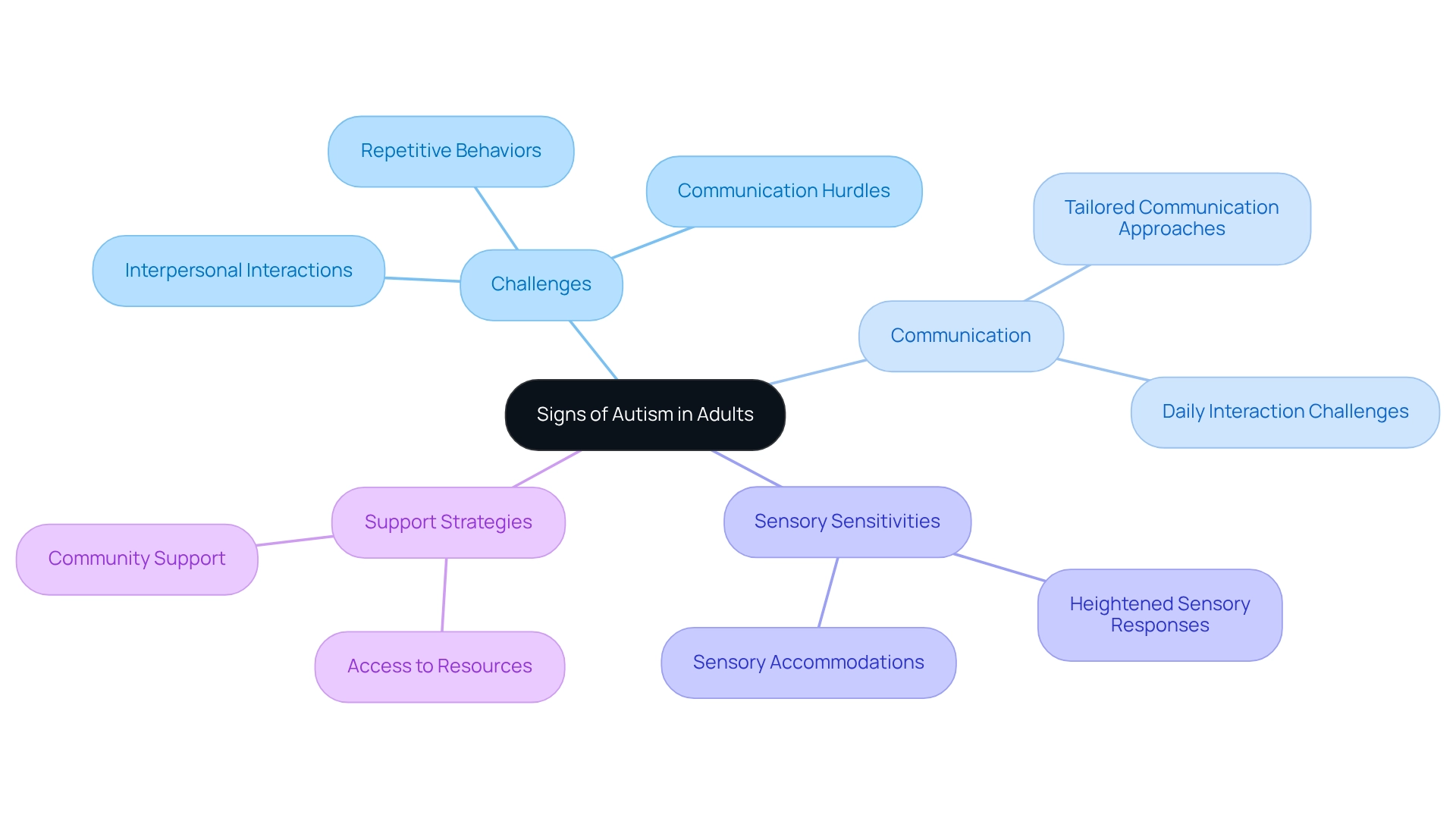
When to Seek Professional Evaluation: Understanding the Need for Diagnosis
As a parent, noticing signs of autism spectrum disorder in your child can be overwhelming. If you observe several signs of autism spectrum disorder that disrupt daily functioning, it may be time to consider obtaining a professional assessment. Research shows that early intervention can lead to significantly better outcomes for individuals on the autism spectrum. For example, studies of Early Intensive Behavioral Intervention (EIBI) reveal no adverse effects, highlighting the effectiveness of these early strategies.
Experts caution that intelligence assessments at age four may not be reliable. Eric Fombonne, a professor of psychiatry at Oregon Health and Science University, notes, "a diagnosis of intellectual disability at that age could change as the individual matures." This underscores the importance of seeking a professional evaluation as soon as possible. The earlier the diagnosis, the more likely children will benefit from tailored interventions that enhance their development and quality of life.
A longitudinal study has shown significant increases in the prevalence of developmental disorders, particularly in Missouri and Wisconsin, attributed to improved access to educational records. This finding emphasizes how crucial data accessibility is in understanding trends related to developmental disorders and the need for timely assessments.
Ultimately, a timely professional evaluation not only opens doors to essential resources but also lays the groundwork for successful outcomes in managing the signs of autism spectrum disorder. If you have concerns, reach out to healthcare professionals or autism specialists to discuss your observations and take that important first step in the evaluation process.
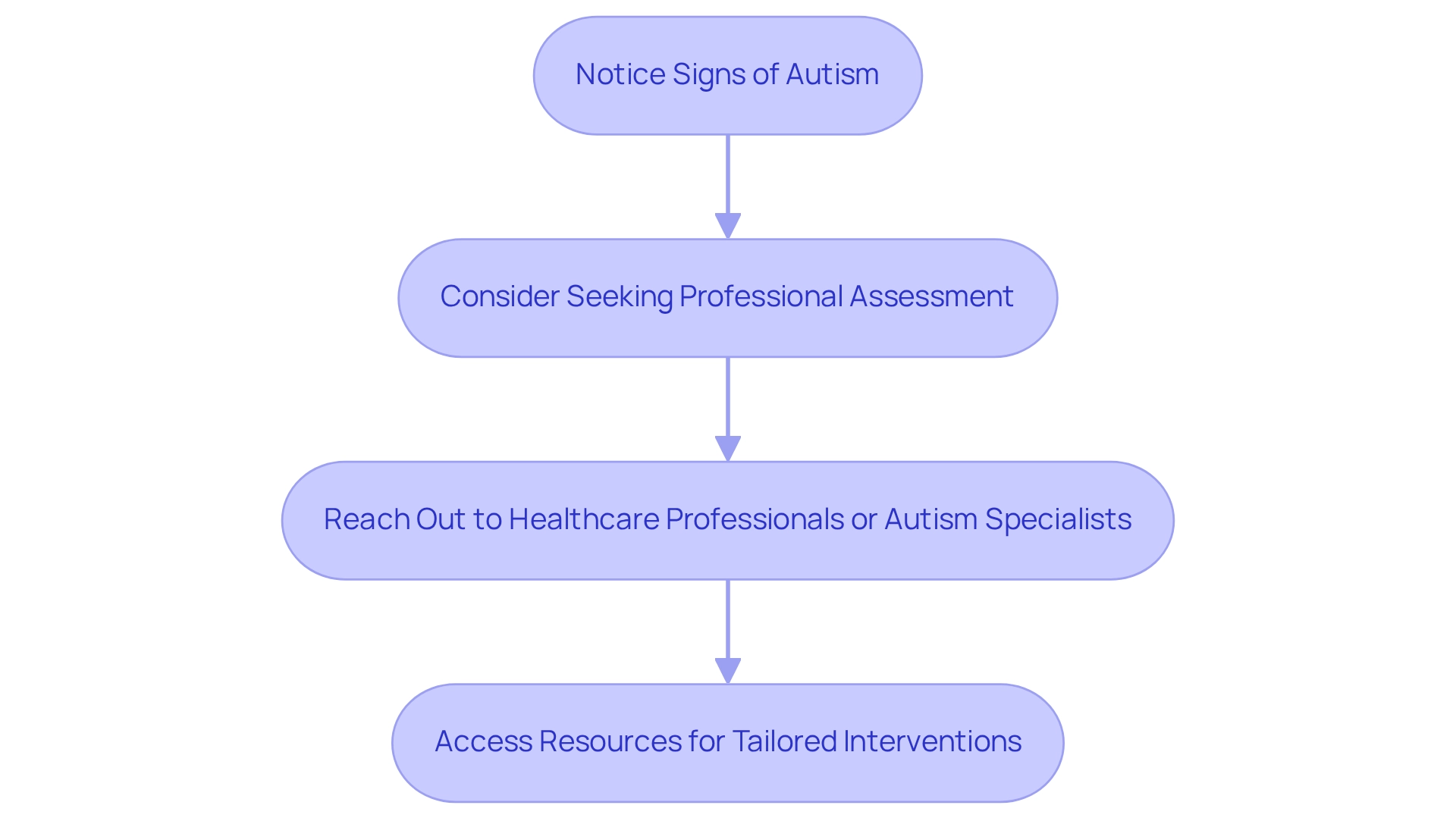
Conclusion
Recognizing the signs of autism across various age groups is crucial for fostering understanding and support within families and communities. Early identification is essential; developmental delays in infants, social communication difficulties, and sensory sensitivities often manifest in early childhood. By remaining vigilant and proactive, parents can facilitate timely interventions that significantly improve outcomes for their children.
As children grow, the signs of autism may evolve, presenting unique challenges in social interactions and emotional regulation. Understanding these changes, particularly in older children and teens, can empower parents to provide tailored support that meets their child's specific needs. Additionally, recognizing the distinct patterns in girls with autism and the lifelong challenges faced by adults on the spectrum highlights the necessity for a nuanced approach to diagnosis and intervention.
Ultimately, fostering a compassionate and informed community is essential for enhancing the quality of life for individuals with autism and their families. By prioritizing awareness, early intervention, and ongoing support, caregivers can empower their loved ones to navigate the complexities of autism with confidence and resilience. The journey may be challenging, but with the right resources and understanding, it can lead to profound growth and meaningful connections. Together, we can create a supportive environment where every individual on the spectrum thrives.
Frequently Asked Questions
What resources does ASD Media provide for parents and professionals implementing ABA therapy?
ASD Media offers a comprehensive array of resources and support tailored for parents and professionals, including the latest insights and strategies to address challenges in therapy, aimed at improving outcomes for children with developmental disorders and ADHD.
Why is community support important in managing developmental disorders?
Community support is vital as it empowers caregivers and enhances the effectiveness of therapy interventions, ensuring that both children and their families receive the necessary guidance and resources to manage developmental disorders effectively.
What does the case study "Treatment, Intervention, and Support" reveal?
The case study highlights diverse treatment approaches for autism spectrum disorder and emphasizes the differing support needs between mothers and fathers, showcasing the importance of a collaborative community for successful therapy outcomes.
How can parents recognize early signs of autism spectrum disorder in infants?
Parents should be attentive to signs such as limited eye contact, a lack of response to their name, and reduced social smiling, as research indicates these signs may appear as early as six months.
What do statistics indicate about the identification of autism spectrum disorder in young children?
Statistics show that individuals born in 2018 underwent more assessments and identification of autism spectrum disorder during ages 0–4 compared to those born in 2014, reflecting increased awareness and early intervention initiatives.
What is the significance of early recognition and intervention for children with autism?
Early recognition and intervention can lead to significant improvements in the lives of autistic children, with studies indicating that 78.8% of school-age autistic youths demonstrate positive developmental outcomes by age 10.
What communication difficulties should parents look for in children with autism?
Parents should be aware of key indicators such as a lack of back-and-forth conversation, trouble interpreting cues, and challenges in sharing interests with peers, which can signify communication difficulties associated with autism.
How has the COVID-19 pandemic affected the identification of autism spectrum disorder?
The pandemic caused disruptions in evaluations and ASD identifications, but by mid-2020, a return to higher identification rates was observed, highlighting the need for ongoing vigilance in recognizing communication difficulties.
What role do Individualized Education Programs (IEPs) play for autistic students?
IEPs are crucial for fostering academic success among autistic students by providing tailored educational approaches that address their unique needs and support their development.




